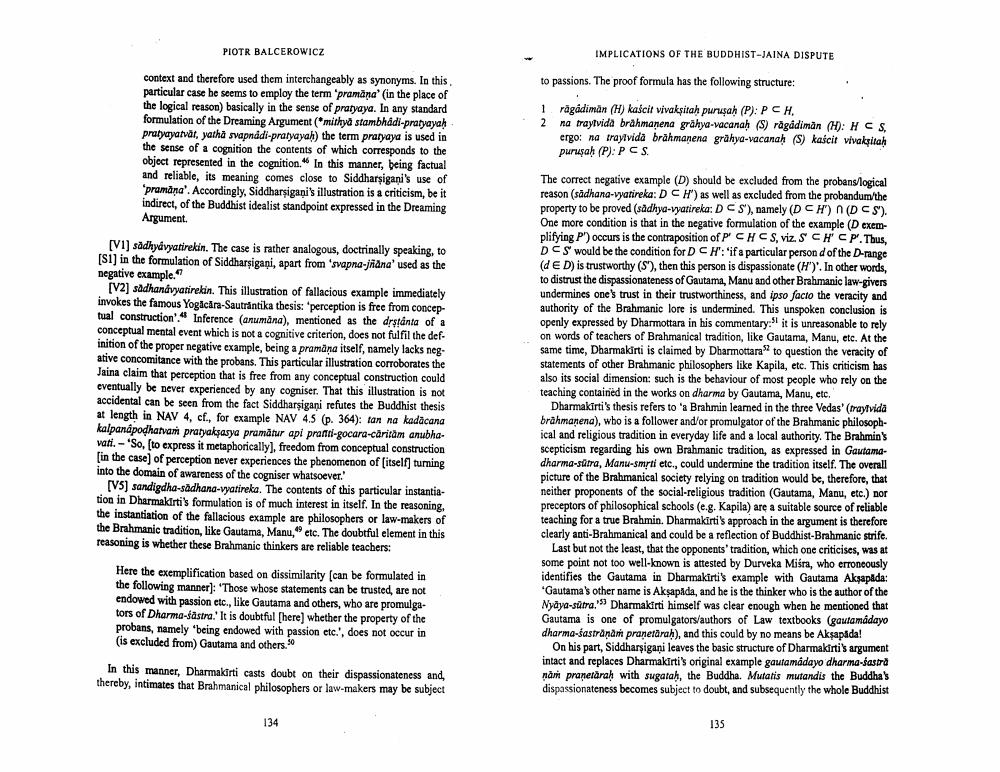________________
PIOTR BALCEROWICZ
IMPLICATIONS OF THE BUDDHIST-JAINA DISPUTE
to passions. The proof formula has the following structure:
1 2
context and therefore used them interchangeably as synonyms. In this particular case be seems to employ the term 'pramana' in the place of the logical reason) basically in the sense of pratyaya. In any standard formulation of the Dreaming Argument (*mithya stambhadi-pratyayah pratyayatvar, yatha swapnadi-pratyayah) the term pratyaya is used in the sense of a cognition the contents of which corresponds to the object represented in the cognition. In this manner, being factual and reliable, its meaning comes close to Siddharsigan *pramana'. Accordingly, Siddharşigani's illustration is a criticism, be it indirect, of the Buddhist idealist standpoint expressed in the Dreaming Argument
ragadiman (H) kaścit vivaksitah puresah (P): PCH na traylvida brahmanena grähya-vacanah (S) ragddiman (H): HCS ergo: na traylvida brāhmanena grähya-vacanah (s) kascit vivaksitah purush (P): PCS
(VI) sadhyávyatirekin. The case is rather analogous, doctrinally speaking, to [S1) in the formulation of Siddharsigani, apart from 'svapna.jana' used as the negative example.
[V2] sadhandvyatirekin. This illustration of fallacious example immediately invokes the famous Yogacara-Sautrántika thesis: 'perception is free from conceptual construction. Inference (anumana), mentioned as the drstanta of a conceptual mental event which is not a cognitive criterion does not fulfil the def inition of the proper negative example, being a pramana itself, namely lacks neg. ative concomitance with the probans. This particular illustration corroborates the Jaina claim that perception that is free from any conceptual construction could eventually be never experienced by any cogniser. That this illustration is not accidental can be seen from the fact Siddharsigani refutes the Buddhist thesis at length in NAV 4, cf, for example NAV 4.5 (p. 364): tan na kadacana kalpanápodhatvani pratyaksasya pramatur api prani-gocara-caritam anubhavati. -"So, (to express it metaphorically), freedom from conceptual construction [in the case) of perception never experiences the phenomenon of itself turning into the domain of awareness of the cogniser whatsoever.'
[V5) sandigdha-sadhana-vyatireka. The contents of this particular instantia. tion in Dharmakdrti's formulation is of much interest in itself. In the reasoning. the instantiation of the fallacious example are philosophers or law-makers of the Brahmanic tradition, like Gautama, Manu. etc. The doubtful element in this reasoning is whether these Brahmanic thinkers are reliable teachers:
The correct negative example (D) should be excluded from the probanslogical reason (sadhana-watireka: DCH') as well as excluded from the probandum/the property to be proved (sadhya-vyatireka: DCS), namely (D CH') n(DCS). One more condition is that in the negative formulation of the example (D exemplifying P) occurs is the contraposition of P CHCS, víz S CH CP. Thus, DCS would be the condition for DCH: 'ifa particular person d of the D-range (d E D) is trustworthy (S), then this person is dispassionate (H)'. In other words, to distrust the dispassionateness of Gautama, Manu and other Brahmanic law-givers undermines one's trust in their trustworthiness, and ipso facto the veracity and authority of the Brahmanic lore is undermined. This unspoken conclusion is openly expressed by Dharmottara in his commentary it is unreasonable to rely on words of teachers of Brahmanical tradition, like Gautama, Manu, etc. At the same time, Dharmakirti is claimed by Dharmottara to question the veracity of statements of other Brahmanic philosophers like Kapila, etc. This criticism has also its social dimension: such is the behaviour of most people who rely on the teaching contained in the works on dharma by Gautama, Manu, etc.
Dharmakirti's thesis refers to 'a Brahmin leared in the three Vedas' (traytvida brahmanena), who is a follower and/or promulgator of the Brahmanic philosopbical and religious tradition in everyday life and a local authority. The Brahmin's scepticism regarding his own Brahmanic tradition, as expressed in Gautamadharma-sútra, Manu smrti etc., could undermine the tradition itself. The overall picture of the Brahmanical society relying on tradition would be, therefore, that neither proponents of the social-religious tradition (Gautama, Manu, etc.) por preceptors of philosophical schools (e.g. Kapila) are a suitable source of reliable teaching for a true Brahmin. Dharmakirti's approach in the argument is therefore clearly anti-Brahmanical and could be a reflection of Buddhist-Brahmanic strife.
Last but not the least, that the opponents' tradition, which one criticises, was at some point not too well-known is attested by Durveka Mišra, who erroneously identifies the Gautama in Dharmakirti's example with Gautama Aksapada: "Gautama's other name is Aksapada, and he is the thinker who is the author of the Nyaya-sútra." Dharmakirti himself was clear enough when he mentioned that Gautama is one of promulgators/authors of Law textbooks (gautamádayo dharma-sastraan pranetarah), and this could by no means be Aksapada!
On his part, Siddharsigani leaves the basic structure of Dharmakirti's argument intact and replaces Dharmakirti's original example gautamádayo dharma-fastra nant pranetarah with sugatah, the Buddha. Mutatis mutandis the Buddha's dispassionateness becomes subject to doubt, and subsequently the whole Buddhist
Here the exemplification based on dissimilarity can be formulated in the following manner): "Those whose statements can be trusted, are not endowed with passion etc., like Gautama and others, who are promulgators of Dharma-fastra.' It is doubtful [here) whether the property of the probans, namely 'being endowed with passion etc.', does not occur in (is excluded from) Gautama and others.
In this manner, Dharmakarti casts doubt on their dispassionateness and thereby, intimates that Brahmanical philosophers or law-makers may be subject
134
135




